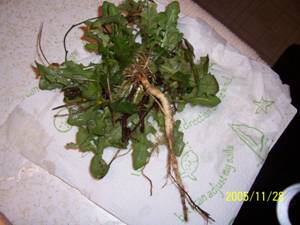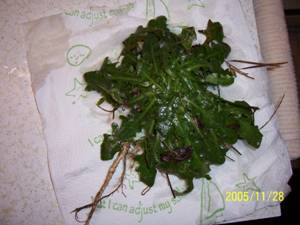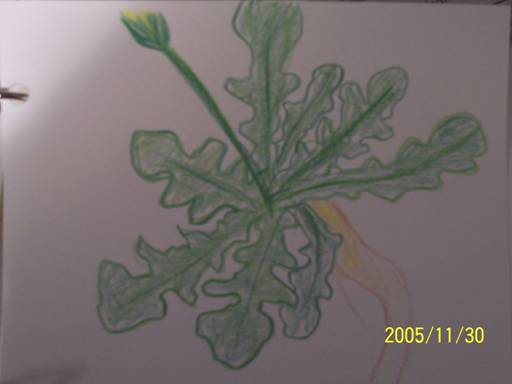Dandelion
Aster or Sunflower Family
Asteraceae
Latin Name: Taraxacum Officinale
Common Names: The Lion’s Tooth, Blowball, Pee in bed
Related Species: Yarrow (Achillea millefolium) and Chicory (Cichorium intybus)
![]() Body System Affiliations:
Body System Affiliations:
- Digestive System
- Circulatory System
Botanical Description:
Habitat: The dandelion is a perennial herb that is born on the ground. It is commonly found in grassy areas [http://plants.usda.gov/cgi_bin/topics.cgi?earl=plant_profile.cgi&symbol=TAOFO].
Size: Leaves 5-25 cm long, Stem 4-30 cm above the leaves, Flower 2-5 cm in diameter [http://en.wikipedia.org/wiki/Dandelion].
Arrangement: The leaf arrangement is whorled or basal rosette.
Leaves: The leaves are lobed or serrated with an oblong shape. The width is approximately ½-1 inch and they are often purple at the base.
Flowers: The stems produce a single, yellow flower head made up of hundreds of small petals. A rosette can produce multiple stems. Each petal represents one seed.
Fruits: Also known as puff-balls, the fruits mature from the blossoms to form a whitish globe of seeds that are carried by the wind.
Underground Parts: Dandelions have a taproot, which are somewhat of a dark brown color on the outside and a milky white color on the inside [http://www.turffiles.ncsu.edu/TurfID_Dev/csPagedPdField.aspx?PlantID=TAROF].
![]()
Ecology:
Habitat: The dandelion can be found in a variety of environments but is most commonly found in disturbed areas.
Range: Dandelions can be found in grassy areas, meadows, cracks in cement and many other similar areas [http://www.fs.fed.us/database/feis/plants/forb/taroff/all.html.].
Native Where: It is a native of Europe and Asia.
Ecological Relationships: The dandelion is known as the pest in lawns because it tends to choke out other plants [http://www.woodrow.org/teachers/bi/2000/Ethnobotany/dandelion.html].
Places/Dates Observed/Description:
Field on 15 th Ave/11-13-05/Grassy field area with multiple rosettes in a single area.
Front yard 15 th Ave/ 11-27-05/Rockbed with other plants, 2 rosettes in a single area
![]()
Propagation:
Technique: Reproduction develops from an unfertilized seed that is carried by wind or other factors from the stem.
Timing: Generally propagation occurs in the spring. [http://medplant.nmsu.edu/taraxcum.html]
![]()
Harvest:
Plant Part: Leaves and root
Season of Harvest: Generally available all year but best harvested in the fall.
Ecological Considerations of Harvest: Medicinal potency is stronger in mountainous areas due to seasonal changes.
Cultural Considerations of Harvest: Recognize that this is a medicinal herb that has been used for many years by different people and for different reasons so to look at it as just a pestering lawn hazard, think about it in terms of a respected treatment for ailments of the human body.
Cautions: Dandelion is generally considered safe and produces no cautions during the harvest.
Other: Flowers and stems may also be harvested for teas and/or as a skin treatment.
![]()
Indigenous and Non-Western Use/Significance/Relationships:
Food: In ancient times, leaves have been eaten plainly as a salad as well as made into teas. Roots have also been made into teas.
Medicine:
Indigenous Group: Asians, Arabs and Europeans [http://world.std.com/~krahe/html2a.html], Native American Groups: The Fox, Tewa, Mohegans [Reader’s Digest:38].
Part Used: Leaves
Medicinal Actions: Used for breast cancer ( China), diuretic w/potassium [Baker:158], relieve chest pains, speed healing of broken bones [Reader’s Digest:38]..
Indications: Chest pains, broken bones
Body System Associations: Digestive and Circulatory
Energetics:
Harvest: Best harvested when leaves are young.
Storage:
Preparation: Wash thoroughly after harvest
Applications: Salads, ground leaves, topical for bruises and possibly warts
Pharmacy: Eat as needed as a diuretic, for treatment of broken bones or apply to skin
Cautions: None
Medicine:
Indigenous Group: Europeans and Arabs, Persians and East Indians, Native American Tribe: The Mohegans
Part Used: Root
Medicinal Actions: Liver detoxification/blood purifier as a tonic
Indications:
Body System Associations: Skin,Digestive and Circulatory
Energetics:
Harvest: Best if harvested in the fall.
Storage:
Preparation:
Applications:
Pharmacy:
Cautions: None
Other: The stems may have also been used to treat warts.
![]()
Western (European-American) Uses/Relationships:
Food: Both leaves and roots are still used as they were traditionally. Leaves are still used in salads and roots are more commonly now than before, roasted. Both can be used for teas, fried and eaten raw as well [Crow:119].
Materials/Technology: The use of dandelions stretches quite far. Not only is it a multipurpose herb, it also can produce two different color dyes.
Medicine:
Part Used: Leaves
Medicinal Actions: Diuretic w/potassium, appetite stimulant
Indications: Skin disorders such as; eczema, dermatitis, scurvy and acne [Baker:159], upset stomach, flatulence, edema
Body System Associations: Digestive and Circulatory
Constituents: Potassium, sesquiterpene lactones, vitamins A,B,C,D, iron, zinc, magnesium, silicon, manganese, taraxacin and phenolic acids [http://www.truestarhealth.com/Notes/2078009.html]
Harvest: Best if harvested in the fall.
Storage: Store leaves in a crisper, do not freeze because they lose medicinal value [Baker:162].
Preparation: Wash thoroughly,dry or use fresh leaves, ground
Applications: Cook or use in a salad
Pharmacy:
~ Dried leaf infusion: 4 to 10 g three times a day
~Herb (stems and leaves): 4 to 10 g three times a day
~ Leaf tincture (1:5) in 30% alcohol: 100 to 150 drops three times a day
~Powdered extract (4:1) leaf: 500 mg one to three times a day
[http://www.umm.edu/altmed/ConsHerbs/Print/Dandelionch.html]
Cautions: Use caution when taking other diuretics, may cause dehydration.
Medicine:
Part Used: Root
Medicinal Actions: Liver detoxification/blood purifier as a tonic or tincture, laxative, gallstone prevention
Indications: Jaundice, hepatitis, cholesterol, blood pressure, urinary tract or kidney ailments, heartburn, indigestion, constipation, hemorrhoids [Baker:159]
Body System Associations: Skin,Digestive and Circulatory
Constituents: Taraxacin, taraxacerin, resin, inulin, pectin [http://www.herbdatanz.com/dandelion_picture_monograph.htm]
Harvest: Best if harvested in the fall.
Storage: Store roots in a crisper while not being used in tonics or tinctures, do not freeze because they lose medicinal value [Baker:162]. Preparation: Wash thoroughly, chop, dry, ground or roast
Applications: Use in teas, tinctures or as tonics, coffee substitute
Pharmacy:
~ Dried root decoction: 2 to 8 g three times a day
~Powdered extract (4:1) root: 500 mg one to three times a day ~Root tincture (1:2) fresh root in 45% alcohol: 100 to 150 drops three times a day
[http://www.umm.edu/altmed/ConsHerbs/Print/Dandelionch.html]
Cautions: Generally the dandelion is seen as safe but there are some precautionary guidelines to be sure the use of dandelion will not effect current prescriptions or ailments.
*May help to prevent but should not be used as treatment for gallstones.
*Dandelion should be avoided during antibiotic treatment due to blocking of concentration of medicine.
*Due to the increase of bile production, those who have obstructions of the bile ducts or other gallbladder diseases dandelion should not be used.
*Known allergies of plants related to the dandelion such as chamomile and yarrow, should take precautions using dandelion.
*Safety in young children, pregnant or nursing women, or those with severe kidney or liver disease has not been established.
*Lithium patients must use caution due to risk of dehydration.
[http://healthlibrary.epnet.com/GetContent.aspx?deliverycontext=&touchurl=&CallbackURL=&token=8482e079-8512-47c2-960c-a403c77a5e4c&chunkiid=21667&docid=/tnp/pg000481]
*In some studies dandelion has shown potential to increase the production of insulin, therefore caution must be taken with those currently taking medications to decrease glucose levels [http://www.drugdigest.org/DD/PrintablePages/herbMonograph/0,11475,4025,00.html]
Other: Although dandelion has potential to lower glucose levels, this may be of interest to those who may want to try natural treatments. It was found in some preliminary studies that this herb may help to normalize blood sugars as well as improve lipid profiles.
![]()
Personal Experience:
Food: I used the root in tincture form as an additive to tea.
Medicine:
Part Used: Root
Medicinal Actions: Boost liver function
Indications: Liver failure diagnosed in May 2005
Body Systems Associations: Digestive and Circulatory
Constituents: Taraxacin, taraxacerin, resin, inulin, pectin [http://www.herbdatanz.com/dandelion_picture_monograph.htm]
Harvest:
Site Location: My front yard
Site Description: The dandelion grew in a decorative rock bed in front of my house. At the time of harvest, the sky was darkening, the soil was very damp from previous rain and the air was cold. Also in the rocky area are three rhododendron plants. I sought out only one whole plant large enough to get a decent sized root. There is no evidence of animal activity but obviously the location was an active area for human activity. The reason for this selection from my front yard is to prove how easy it is to my family and me to prepare something naturally healthy and very useful. Its multiple uses and accessibility made this much easier with my busy schedule.
Technique: I sought out an area that would be easily accessible because this may become an herb regularly used in my house. I used a spoon and cleared the rocks from around the plant to ensure that I was able to get the entire root.
Processing: Once I harvested the dandelion, I washed it, chopped it and measured with a ratio of 1:2 using vinegar.
Storage: I keep the jar in the refrigerator covered with plastic under the metal lid.
Experience: This was an overall interesting experience for me because I rarely have time to dig in the dirt. I enjoyed it and will continue to use this experience as a reference for future harvests.
Application: I made a tincture of dandelion root and vinegar.
Preparation: First I harvested and then washed the root to get the dirt off. I then chopped it and measured both the root and the vinegar.
Pharmacy: Due to my father’s condition, I gave him a single teaspoon each day in a cup of tea in order to not run risk of having too much added with his current medications.
Reason/Purpose: My father is dying of liver failure currently due to the multiple illnesses he has. The main reason for using the dandelion was to boost liver function and in order to have it functioning even slightly better.
Experience: My father did not like the taste of it but he drank it. After hospitalization November 20-23, I stopped giving him the tincture because they believed he had a possible obstruction in his digestive system which is a caution of the use of this herb. Although I had to stop the tincture, his blood work in the hospital had shown a tremendous decrease in his ammonia levels making them normal. The previous ammonia levels he had were high enough for most people to be hospitalized and they have been at those levels throughout this whole year. It is a possibility that the dandelion tincture played a role because it is the only change in his diet but that is not known for sure.
Cautions based on experience: As mentioned above, the digestive obstruction became a caution in the use of the dandelion root.
![]()
Cautions: Generally the dandelion is seen as safe but there are some precautionary guidelines to be sure the use of dandelion will not effect current prescriptions or ailments.
*May help to prevent but should not be used as treatment for gallstones.
*Dandelion should be avoided during antibiotic treatment due to blocking of concentration of medicine.
*Due to the increase of bile production, those who have obstructions of the bile ducts or other gallbladder diseases dandelion should not be used.
*Known allergies of plants related to the dandelion such as chamomile and yarrow, should take precautions using dandelion.
*Safety in young children, pregnant or nursing women, or those with severe kidney or liver disease has not been established.
*Lithium patients must use caution due to risk of dehydration.
[http://healthlibrary.epnet.com/GetContent.aspx?deliverycontext=&touchurl=&CallbackURL=&token=8482e079-8512-47c2-960c-a403c77a5e4c&chunkiid=21667&docid=/tnp/pg000481]
*In some studies dandelion has shown potential to increase the production of insulin, therefore caution must be taken with those currently taking medications to decrease glucose levels [http://www.drugdigest.org/DD/PrintablePages/herbMonograph/0,11475,4025,00.html]
![]()
Pictures and Drawings:

Photographs by: Stephanie Nuñezgil


Drawing by: Stephanie Nuñezgil 11-27-2005
![]()
References Cited:
- Baker, Jerry. Herbal Pharmacy. Wixom, Michigan: American Master Products, Inc., 2000.
- Balch, Phyllis A. “Dandelion Root.” Jan. 2002. Online at http://eatmoreherbs.com/zine/11_dandelion.html. Visited 11-1-2005.
- Carter, Jermaine, Andrea Medina and Alice Nevarez. “Medicinal Plants of the SW: Dandelion.” 2002. Online at http://medplant.nmsu.edu/taraxcum.html. Visited 11-27-2005.
- Crow, Tis Mal. Native Plants Native Healing. Summertown, Tennessee: Native Voices Book Publishing Company, 2001.
- Family Guide to Natural Medicine. Reader’s Digest. Pleasantville, New York/ Montreal: The Reader’s Digest Association, Inc., 1993.
- Author Unknown. “Dandelion.” Drugs & Vitamins-Drug Library-DrugDigest. Online at http://www.drugdigest.org/DD/PrintablePages/herbMonograph/0,11475,4025,00.html. Visited 11-27-2005.
- Author Unknown. “Dandelion.” Ebsco Publishing. Last Updated Aug. 2003. Online at http://healthlibrary.epnet.com/GetContent.aspx?deliverycontext=&touchurl=&CallbackURL=&token=8482e079-8512-47c2-960c-a403c77a5e4c&chunkiid=21667&docid=/tnp/pg000481. Visited 11-1-2005
- Author Unknown. “Taraxacum Officinale.” Herbdata New Zealand. 2002. Online at http://www.herbdatanz.com/dandelion_picture_monograph.htm . Visited 11-13-2005.
- Author Unknown. “Dandelion.” Truestar Health & Healthnotes, Inc. 2005. Online at http://www.truestarhealth.com/Notes/2078009.html . Visited 11-27-2005.
- Author Unknown. “Dandelion.” Google Keyword “Dandelion.” Online at http://www.woodrow.org/teachers/bi/2000/Ethnobotany/dandelion.html . Visited 11-28-2005.
- Author Unknown. “Taraxacum Officinale.” United States Department of Agriculture. NRCS Plants Profile. Online at http://plants.usda.gov/cgi_bin/topics.cgi?earl=plant_profile.cgi&symbol=TAOFO . Visited 11-13-2005.
- Author Unknown. “Dandelion.” Wikipedia. Last Updated Nov. 18, 2005. Online at http://en.wikipedia.org/wiki/Dandelion. Visited 11-27-2005.
- Author Unknown. “Dandelion.” NC State University TurfFiles. 2005. Online at http://www.turffiles.ncsu.edu/TurfID_Dev/csPagedPdField.aspx?PlantID=TAROF . Visited 11-27-2005.
- Author Unknown. “Species: Taraxacum Officinale.” Google Keyword “Dandelion.” Online at http://www.fs.fed.us/database/feis/plants/forb/taroff/all.html . Visited 11-13-2005.
- Author Unknown. “Uses and Properties 1.” Google Keyword “Dandelion.” Online at http://world.std.com/~krahe/html2a.html . Visited 11-27-2005.
- Author Unknown. “Dandelion.” A.D.A.M., Inc. 2004. Online at http://www.umm.edu/altmed/ConsHerbs/Print/Dandelionch.html. Visited 11-27-2005.
![]()
Stephanie Nuñezgil – Arts, The Environment and The Child – Fall 2005